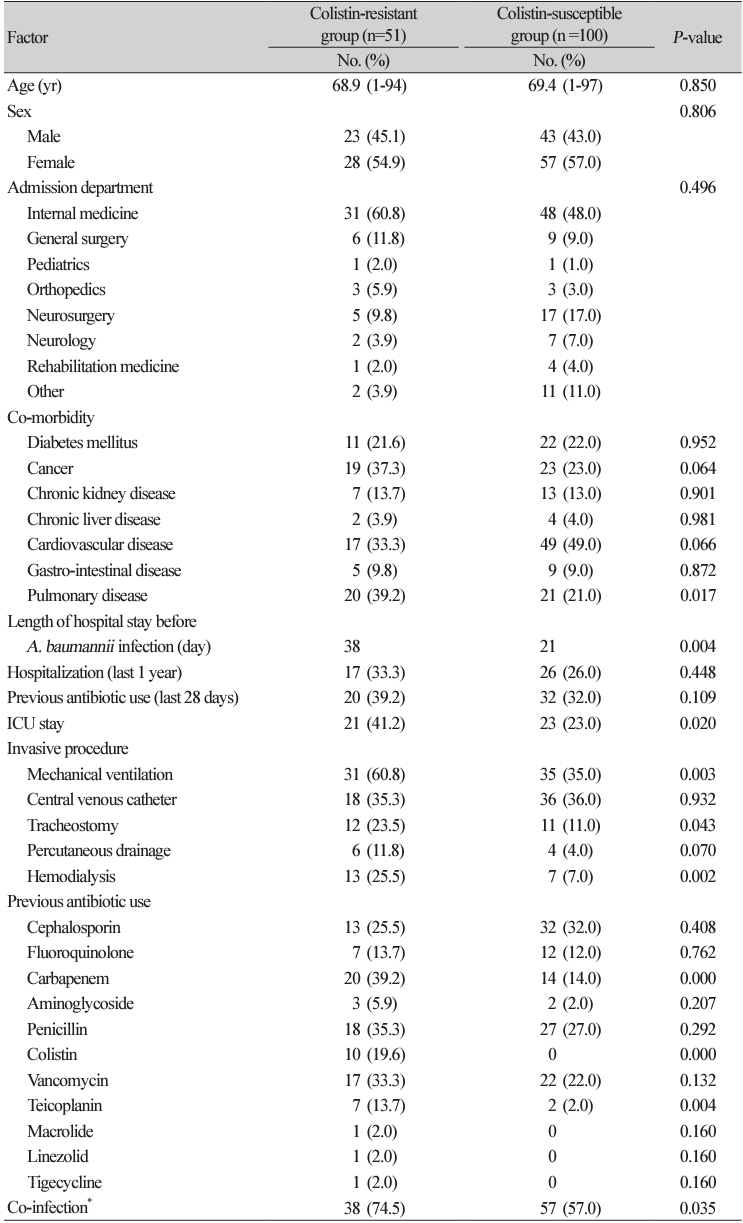Abstract
Acinetobacter baumannii is an important cause of healthcare-associated infections and is resistant to almost all antimicrobial agents, with strains recently reported to be resistant to colsitin. In this study, we aimed to identify the risk factors associated with colistin-resistant A. baumannii infections by comparing colistin-resistant and -susceptible A. baumannii isolates. We retrospectively reviewed the medical records of 51 and 100 cases in which colistinresistant and -susceptible A. baumannii were isolated, respectively. Univariate analysis showed that compared with patients with colistin-sensitive infections, patients with colistinresistant A. baumanni infections had a combined pulmonary disease (P = 0.017), were admitted to intensive care unit (P = 0.020), and had prior mechanical ventilation (P = 0.003), tracheostomy (P = 0.043), percutaneous drainage (P = 0.070), hemodialysis (P = 0.002); use of colistin (P = 0.000), carbapenem (P = 0.000), and teicoplanin (P = 0.004); and co-infection (P = 0.035). Multivariate analysis indicated that eight variables were related to the likelihood of colistin-resistant A. baumanni infections: use of teicoplanin (Odds ratio [OR]: 3.140, 95% confidence interval [CI]: 0.529–18.650), prior hemodialysis (OR: 2.722, 95% CI: 0.851–8.709), combined pulmonary disease (OR: 2.286, 95% CI: 0.998–5.283), prior use of carbapenem (OR: 0.199, 95% CI: 0.863–5.603), co-infection (OR: 1.706, 95% CI: 0.746–3.898), prior mechanical ventilation (OR: 1.614, 95% CI, 0.684–3.809), intensive care unit admission (OR: 1.387, 95% CI: 0.560–3.435), and prior tracheostomy (OR: 1.102, 95% CI: 0.344–3.527); however, no statistical differences were observed. Although colistin use could not be proven in multivariate analysis, the possibility of being a risk factor cannot be ruled out.
Go to : 
[in Korean]
Ethics statement
This study was approved by the institutional review board of Ewha Womans University Mokdong Hospital (IRB No. EUMC 2019-09-013-003). The board exempted the obtainment of informed consent.
Conflicts of interest
Hae-Sun Chung has been an editor-in-chief of the Annals of Clinical Microbiology since January 2022. However, she was not involved in the review process of this article. No other potential conflict of interest relevant to this article was reported.
Funding
This research was supported by EWHA Education and Research Center for Infection Research Fund, grant number 201900610001. The funders had no role in study design, data collection and analysis, decision to publish, or preparation of the manuscript.
REFERENCES
1. Moubareck CA and Halat DH. Insights into Acinetobacter baumannii: a review of microbiological, virulence, and resistance traits in a threatening nosocomial pathogen. Antibiotics 2020;9:119.
.
2. Division of Antimicrobial Resistance Control, Korea Disease Control and Prevention Agency. National antimicrobial resistance surveillance in Korea 2020 Annual Report. Cheongju; Korea Disease Control and Prevention Agency, 2021:125-6.
.
3. Karakonstantis S, Kritsotakis EI, Gikas A. Pandrug-resistant Gram-negative bacteria: a systematic review of current epidemiology, prognosis and treatment options. J Antimicrob Chemother 2020;75:271-82.
.
4. Biswas S, Brunel JM, Dubus JC, Reynaud-Gaubert M, Rolain JM. Colistin: an update on the antibiotic of the 21st century. Expert Rev Anti Infect Ther 2012;10:917-34.
.
5. Pormohammad A, Mehdinejadiani K, Gholizadeh P, Nasiri MJ, Mohtavinejad N, Dadashi M, et al. Global prevalence of colistin resistance in clinical isolates of Acinetobacter baumannii: a systematic review and meta-analysis. Microb Pathog 2020;139:103887.
.
6. Novovic K and Jovcic B. Colistin resistance in Acinetobacter baumannii: molecular mechanisms and epidemiology. Antibiotics 2023;12:516.
.
7. Richter SE, Miller L, Uslan DZ, Bell D, Watson K, Humphries R, et al. Risk factors for colistin resistance among Gram-negative rods and Klebsiella pneumoniae isolates. J Clin Microbiol 2018;56:e00149-18.
.
8. Giamarellou H. Epidemiology of infections caused by polymyxin-resistant pathogens. Int J Antimicrob Agents 2016;48:614-21.
.
9. van Duin D and Doi Y. Outbreak of colistin-resistant, carbapenemase-producing Klebsiella pneumoniae: are we at the end of the road? J Clin Microbiol 2015;53:3116-7.
.
10. Mantzarlis K, Makris D, Zakynthinos E. Risk factors for the first episode of Acinetobacter baumannii resistant to colistin infection and outcome in critically ill patients. J Med Microbiol 2020;69:35-40.
.
11. Yilmaz GR, Dizbay M, Guven T, Pullukcu H, Tasbakan M, Guzel OT, et al. Risk factors for infection with colistin-resistant gram-negative microorganisms: a multicenter study. Ann Saudi Med 2016;36:216-22.
.
12. Inchai J, Liwsrisakun C, Theerakittikul T, Chaiwarith R, Khositsakulchai W, Pothirat C. Risk factors of multidrug-resistant, extensively drug-resistant and pandrug-resistant Acinetobacter baumannii ventilator-associated pneumonia in a Medical Intensive Care Unit of University Hospital in Thailand. J Infect Chemother 2015;21:570-4.
.
13. Matthaiou DK, Michalopoulos A, Rafailidis PI, Karageorgopoulos DE, Papaioannou V, Ntani G, et al. Risk factors associated with the isolation of colistin-resistant gram-negative bacteria: a matched case-control study. Crit Care Med 2008;36:807-11.
.
14. Elham B and Fawzia A. Colistin resistance in Acinetobacter baumannii isolated from critically ill patients: clinical characteristics, antimicrobial susceptibility and outcome. Afr Health Sci 2019;19:2400-6.
.
Go to : 




 PDF
PDF Citation
Citation Print
Print





 XML Download
XML Download